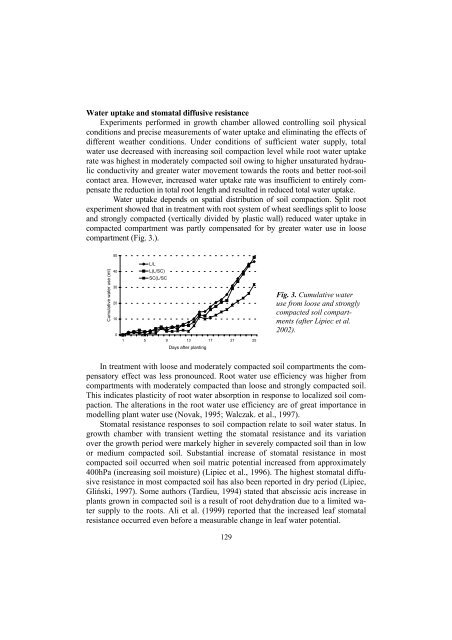soil - Lublin
soil - Lublin
soil - Lublin
Create successful ePaper yourself
Turn your PDF publications into a flip-book with our unique Google optimized e-Paper software.
Water uptake and stomatal diffusive resistance<br />
Experiments performed in growth chamber allowed controlling <strong>soil</strong> physical<br />
conditions and precise measurements of water uptake and eliminating the effects of<br />
different weather conditions. Under conditions of sufficient water supply, total<br />
water use decreased with increasing <strong>soil</strong> compaction level while root water uptake<br />
rate was highest in moderately compacted <strong>soil</strong> owing to higher unsaturated hydraulic<br />
conductivity and greater water movement towards the roots and better root-<strong>soil</strong><br />
contact area. However, increased water uptake rate was insufficient to entirely compensate<br />
the reduction in total root length and resulted in reduced total water uptake.<br />
Water uptake depends on spatial distribution of <strong>soil</strong> compaction. Split root<br />
experiment showed that in treatment with root system of wheat seedlings split to loose<br />
and strongly compacted (vertically divided by plastic wall) reduced water uptake in<br />
compacted compartment was partly compensated for by greater water use in loose<br />
compartment (Fig. 3.).<br />
50<br />
L/L<br />
Cumulative water use (ml)<br />
40<br />
30<br />
20<br />
10<br />
0<br />
L(L/SC)<br />
SC(L/SC<br />
1 5 9 13 17 21 25<br />
Fig. 3. Cumulative water<br />
use from loose and strongly<br />
compacted <strong>soil</strong> compartments<br />
(after Lipiec et al.<br />
2002).<br />
Days after planting<br />
In treatment with loose and moderately compacted <strong>soil</strong> compartments the compensatory<br />
effect was less pronounced. Root water use efficiency was higher from<br />
compartments with moderately compacted than loose and strongly compacted <strong>soil</strong>.<br />
This indicates plasticity of root water absorption in response to localized <strong>soil</strong> compaction.<br />
The alterations in the root water use efficiency are of great importance in<br />
modelling plant water use (Novak, 1995; Walczak. et al., 1997).<br />
Stomatal resistance responses to <strong>soil</strong> compaction relate to <strong>soil</strong> water status. In<br />
growth chamber with transient wetting the stomatal resistance and its variation<br />
over the growth period were markely higher in severely compacted <strong>soil</strong> than in low<br />
or medium compacted <strong>soil</strong>. Substantial increase of stomatal resistance in most<br />
compacted <strong>soil</strong> occurred when <strong>soil</strong> matric potential increased from approximately<br />
400hPa (increasing <strong>soil</strong> moisture) (Lipiec et al., 1996). The highest stomatal diffusive<br />
resistance in most compacted <strong>soil</strong> has also been reported in dry period (Lipiec,<br />
Gliński, 1997). Some authors (Tardieu, 1994) stated that abscissic acis increase in<br />
plants grown in compacted <strong>soil</strong> is a result of root dehydration due to a limited water<br />
supply to the roots. Ali et al. (1999) reported that the increased leaf stomatal<br />
resistance occurred even before a measurable change in leaf water potential.<br />
129

















